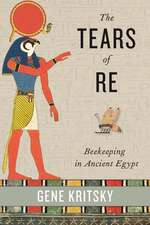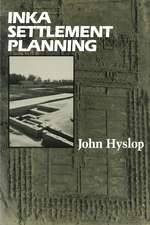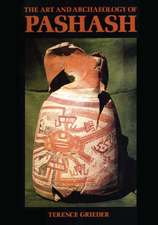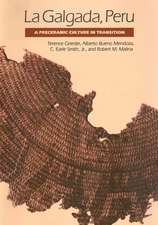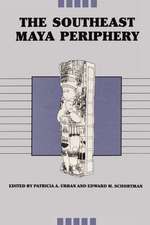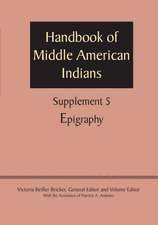The Huarochiri Manuscript: A Testament of Ancient and Colonial Andean Religion
Autor Frank Salomon Contribuţii de George L. Uriosteen Limba Engleză Paperback – sep 1991
The Huarochirí Manuscript holds a summation of native Andean religious tradition and an image of the superhuman and human world as imagined around A.D. 1600. The tellers were provincial Indians dwelling on the west Andean slopes near Lima, Peru, aware of the Incas but rooted in peasant, rather than imperial, culture. The manuscript is thought to have been compiled at the behest of Father Francisco de Avila, the notorious "extirpator of idolatries." Yet it expresses Andean religious ideas largely from within Andean categories of thought, making it an unparalleled source for the prehispanic and early colonial myths, ritual practices, and historic self-image of the native Andeans.
Prepared especially for the general reader, this edition of the Huarochirí Manuscript contains an introduction, index, and notes designed to help the novice understand the culture and history of the Huarochirí-area society. For the benefit of specialist readers, the Quechua text is also supplied.
Preț: 322.49 lei
Nou
Puncte Express: 484
Preț estimativ în valută:
61.72€ • 67.01$ • 51.84£
61.72€ • 67.01$ • 51.84£
Carte tipărită la comandă
Livrare economică 23 aprilie-07 mai
Preluare comenzi: 021 569.72.76
Specificații
ISBN-13: 9780292730533
ISBN-10: 0292730535
Pagini: 288
Ilustrații: 1 Map
Dimensiuni: 216 x 279 x 15 mm
Greutate: 0.65 kg
Editura: University of Texas Press
Colecția University of Texas Press
ISBN-10: 0292730535
Pagini: 288
Ilustrații: 1 Map
Dimensiuni: 216 x 279 x 15 mm
Greutate: 0.65 kg
Editura: University of Texas Press
Colecția University of Texas Press
Notă biografică
Frank Salomon is John V. Murra Professor of Anthropology at the University of Wisconsin, Madison.
George L. Urioste is professor of anthropology at the University of Nevada, Las Vegas.
George L. Urioste is professor of anthropology at the University of Nevada, Las Vegas.
Cuprins
- Acknowledgments
- Introductory Essay: The Huarochirí Manuscript
- The manuscript as testament
- Andean religion and "Inca religion"
- General outline of the Huarochirí manuscript
- Early times and peoples
- The Paria Caca cycle and the myths of group identity
- Chaupi Ñamca and the mythology of gender
- The Incas as seen from Huarochirí
- The Spanish invasion as seen from Huarochirí
- Specialized chapters
- The Huarochirí region's people and their historic situation
- Into the world of the huacas
- Pacha: 'earth, world, time, place'
- Camay: a concept of specific essence and force, 'to charge with being, to infuse with species power'
- Huaca: 'superhuman person, shrine, holy and powerful object'; huaca priesthood
- Yuriy/yumay: concepts of human birth and descent
- Ayllu: corporate landholding collectivity self-defined as ancestor-focused kindred
- Llacta: 'village' as cultic and territorial unit
- The original text
- The possible genesis of the text in the local conjuncture
- Previous editions of the Huarochirí manuscript
- The character of the present translation
- Language substrates and non-Quechua languages
- Quechua other than the "general" dialect
- Language(s) of the Jaqi (Aymara) family
- Non-Quechua, non-Jaqi native lexicon?
- Spanish
- The problem of redaction
- The problem of validation
- Translation of style
- Framing sentences
- Narrative passages
- Versified speech in semantic couplets
- Other translation conventions
- Note conventions
- Transcription conventions
- Toponymic and onomastic spelling conventions
- Language substrates and non-Quechua languages
- Index and glossary
- The Huarochirí Manuscript
- [Preface]
- Chapter 1. How the Idols of Old Were, and How They Warred among Themselves, and How the Natives Existed at That Time
- Chapter 2. How Cuni Raya Vira Cocha Acted in His Own Age. The Life of Cuni Raya Vira Cocha. How Caui Llaca Gave Birth to His Child, and What Followed
- Chapter 3. What Happened to the Indians in Ancient Times When the Ocean Overflowed Chapter 4. How the Sun Disappeared for Five Days. In What Follows We Shall Tell a Story about the Death of the Sun
- Chapter 5. How in Ancient Times Paria Caca Appeared on a Mountain Named Condor Coto in the Form of Five Eggs, and What Followed. Here Will Begin the Account of Paria Caca's Emergence
- Chapter 6. How Paria Caca Was Born as Five Falcons and Then Turned into Persons, and How, Already Victorious over All the Yunca of Anchi Cocha, He Began to Walk toward Paria Caca Mountain, and What Happened along the Way
- Chapter 7. How Those Cupara People Revere the One Called Chuqui Suso Even to This Day
- Chapter 8. How Paria Caca Ascended. How One Man Came Back with His Child by Following Paria Caca's Commands, and, Finally, How He Struggled with Huallallo Caruincho
- Chapter 9. How Paria Caca, Having Accomplished All This, Began to Ordain His Own Cult
- Chapter 10. Who Chaupi Ñamca Was, Where She Dwells, and How She Arranged Her Cult
- Chapter 11. How People Danced the Chanco Dance. In Speaking of These Matters, We Shall Also Tell Who Tutay Quiri, the Child of Paria Caca, Was. The Story Is Like This
- Chapter 12. How Paria Caca's Children Undertook the Conquest of All the Yunca People
- Chapter 13. Mama
- Chapter 14.
- Chapter 15. Next We Shall Write about What Was Mentioned in the Second
- Chapter, Namely, Whether Cuni Raya Existed before or after Caruincho
- Chapter 16. Here We Shall Write on Whether Paria Caca, Born from Five Eggs, Was Composed of Brothers or Whether Paria Caca Was Their Father, Things of This Kind
- Chapter 17.
- Chapter 18.
- Chapter 19.
- Chapter 20. Here Begins the Life of Llocllay Huancupa. In What Follows, We Shall Also Write about Its End
- Chapter 21. Although a Dream Is Not Valid, We Shall Speak about That Demon's Frightful Deeds and Also about the Way in Which Don Cristóbal Defeated Him
- Chapter 22.
- Chapter 23. We Shall Write Here about the Inca's Summons to All the Huacas. We Shall
- Also Speak Here of Maca Uisa's Victory
- Chapter 24. Next We Shall Write about the Customs of the Checa, the Machua Yunca Festival and Its Dances, and, Finally, about the Origin of the People
- Chapter 25. Here We Shall Write How the Wind Blew the Colli People from Yaru Tini Down to the Lower Yunca
- Chapter 26. How Paria Caca Defeated Maca Calla. How He Established His Children after His Victory
- Chapter 27. How in Former Times, on the Fifth Day after Their Death, People Said, "I'm Back!" We Shall Write about These Things
- Chapter 28. How People Used to Feed the Spirits of the Dead during Paria Caca's Festival and How They Thought about All Saints' Day in Former Times
- Chapter 29. How Something Called the Yacana Comes Down from the Sky to Drink Water. We Shall Also Speak about the Other Stars and Their Names
- Chapter 30. How Two Huacas, a Male and a Female, Dwell in the Lake of the Allauca in Purui. We Shall Write about Their Lives
- Chapter 31. As in the Previous Chapter We Spoke about the Existence of a Certain Lake, Likewise We Shall Now Tell about the Lake of the Concha Ayllu, the One Called Yansa. The Story Is Like This
- [Supplement I]
- [Supplement II]
- Transcription of the Huarochirí Manuscript
- Glossary of Untranslated Words
- Bibliographic References
- Index
Recenzii
This work represents the most fulsome and developed narrative available to us of how local people in a provincial setting in the Inca Empire conceived of their society and its past.... This book will stand for some time as the definitive transcription and English translation of a seminal document in Andean cultural history.
Although some Christian influence is discernible, the Huarochirí cycle is as close as we are likely to come to a purely Andean expression of the supernatural.... Urioste's transcription of the Quechua is included, and an Introductory Essay by Frank Salomon is an excellent study aid for both novices and adepts.
Descriere
The English translation of an important source document for Andean history.



